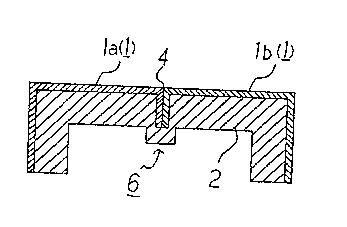Une partie des informations de ce site Web a été fournie par des sources externes. Le gouvernement du Canada n'assume aucune responsabilité concernant la précision, l'actualité ou la fiabilité des informations fournies par les sources externes. Les utilisateurs qui désirent employer cette information devraient consulter directement la source des informations. Le contenu fourni par les sources externes n'est pas assujetti aux exigences sur les langues officielles, la protection des renseignements personnels et l'accessibilité.
L'apparition de différences dans le texte et l'image des Revendications et de l'Abrégé dépend du moment auquel le document est publié. Les textes des Revendications et de l'Abrégé sont affichés :
| (12) Brevet: | (11) CA 2006676 |
|---|---|
| (54) Titre français: | METHODE ET MOULE DE FABRICATION D'UN ARTICLE MOULE MULTICOUCHE |
| (54) Titre anglais: | PROCESS AND MOLD FOR PRODUCING A MULTILAYER MOLDED ARTICLE |
| Statut: | Durée expirée - au-delà du délai suivant l'octroi |
| (51) Classification internationale des brevets (CIB): |
|
|---|---|
| (72) Inventeurs : |
|
| (73) Titulaires : |
|
| (71) Demandeurs : |
|
| (74) Agent: | KIRBY EADES GALE BAKER |
| (74) Co-agent: | |
| (45) Délivré: | 2000-05-23 |
| (22) Date de dépôt: | 1989-12-27 |
| (41) Mise à la disponibilité du public: | 1990-06-27 |
| Requête d'examen: | 1996-12-17 |
| Licence disponible: | S.O. |
| Cédé au domaine public: | S.O. |
| (25) Langue des documents déposés: | Anglais |
| Traité de coopération en matière de brevets (PCT): | Non |
|---|
| (30) Données de priorité de la demande: | ||||||
|---|---|---|---|---|---|---|
|
A multilayer molded article comprising a resin body
and at least one sheet of a skin material, an edge part
of which is positioned on a surface area of the resin
body, is efficiently produced by clamping an edge part of
the skin material or lapped edge parts of adjacent sheets
of skin material during the molding process.
Note : Les revendications sont présentées dans la langue officielle dans laquelle elles ont été soumises.
Note : Les descriptions sont présentées dans la langue officielle dans laquelle elles ont été soumises.

2024-08-01 : Dans le cadre de la transition vers les Brevets de nouvelle génération (BNG), la base de données sur les brevets canadiens (BDBC) contient désormais un Historique d'événement plus détaillé, qui reproduit le Journal des événements de notre nouvelle solution interne.
Veuillez noter que les événements débutant par « Inactive : » se réfèrent à des événements qui ne sont plus utilisés dans notre nouvelle solution interne.
Pour une meilleure compréhension de l'état de la demande ou brevet qui figure sur cette page, la rubrique Mise en garde , et les descriptions de Brevet , Historique d'événement , Taxes périodiques et Historique des paiements devraient être consultées.
| Description | Date |
|---|---|
| Inactive : Périmé (brevet - nouvelle loi) | 2009-12-27 |
| Inactive : CIB de MCD | 2006-03-11 |
| Inactive : CIB de MCD | 2006-03-11 |
| Inactive : CIB de MCD | 2006-03-11 |
| Inactive : CIB de MCD | 2006-03-11 |
| Inactive : CIB de MCD | 2006-03-11 |
| Accordé par délivrance | 2000-05-23 |
| Inactive : Page couverture publiée | 2000-05-22 |
| Inactive : Renseign. sur l'état - Complets dès date d'ent. journ. | 2000-03-13 |
| Inactive : Dem. traitée sur TS dès date d'ent. journal | 2000-03-13 |
| Préoctroi | 2000-02-28 |
| Inactive : Taxe finale reçue | 2000-02-28 |
| Lettre envoyée | 1999-10-08 |
| Un avis d'acceptation est envoyé | 1999-10-08 |
| Un avis d'acceptation est envoyé | 1999-10-08 |
| Inactive : Approuvée aux fins d'acceptation (AFA) | 1999-09-20 |
| Toutes les exigences pour l'examen - jugée conforme | 1996-12-17 |
| Exigences pour une requête d'examen - jugée conforme | 1996-12-17 |
| Demande publiée (accessible au public) | 1990-06-27 |
Il n'y a pas d'historique d'abandonnement
Le dernier paiement a été reçu le 1999-11-04
Avis : Si le paiement en totalité n'a pas été reçu au plus tard à la date indiquée, une taxe supplémentaire peut être imposée, soit une des taxes suivantes :
Veuillez vous référer à la page web des taxes sur les brevets de l'OPIC pour voir tous les montants actuels des taxes.
| Type de taxes | Anniversaire | Échéance | Date payée |
|---|---|---|---|
| TM (demande, 8e anniv.) - générale | 08 | 1997-12-29 | 1997-11-05 |
| TM (demande, 9e anniv.) - générale | 09 | 1998-12-29 | 1998-11-04 |
| TM (demande, 10e anniv.) - générale | 10 | 1999-12-27 | 1999-11-04 |
| Taxe finale - générale | 2000-02-28 | ||
| TM (brevet, 11e anniv.) - générale | 2000-12-27 | 2000-11-08 | |
| TM (brevet, 12e anniv.) - générale | 2001-12-27 | 2001-11-19 | |
| TM (brevet, 13e anniv.) - générale | 2002-12-27 | 2002-11-19 | |
| TM (brevet, 14e anniv.) - générale | 2003-12-29 | 2003-11-17 | |
| TM (brevet, 15e anniv.) - générale | 2004-12-27 | 2004-11-08 | |
| TM (brevet, 16e anniv.) - générale | 2005-12-27 | 2005-11-08 | |
| TM (brevet, 17e anniv.) - générale | 2006-12-27 | 2006-11-08 | |
| TM (brevet, 18e anniv.) - générale | 2007-12-27 | 2007-11-09 | |
| TM (brevet, 19e anniv.) - générale | 2008-12-29 | 2008-11-10 |
Les titulaires actuels et antérieures au dossier sont affichés en ordre alphabétique.
| Titulaires actuels au dossier |
|---|
| SUMITOMO CHEMICAL CO., LTD. |
| Titulaires antérieures au dossier |
|---|
| MATSAHITO MATSUMOTO |
| NOBUHIRO USUI |
| RYUICHI ISHITSUBO |
| SHOHEI MASUI |
| TOSHIHIRO HOSOKAWA |